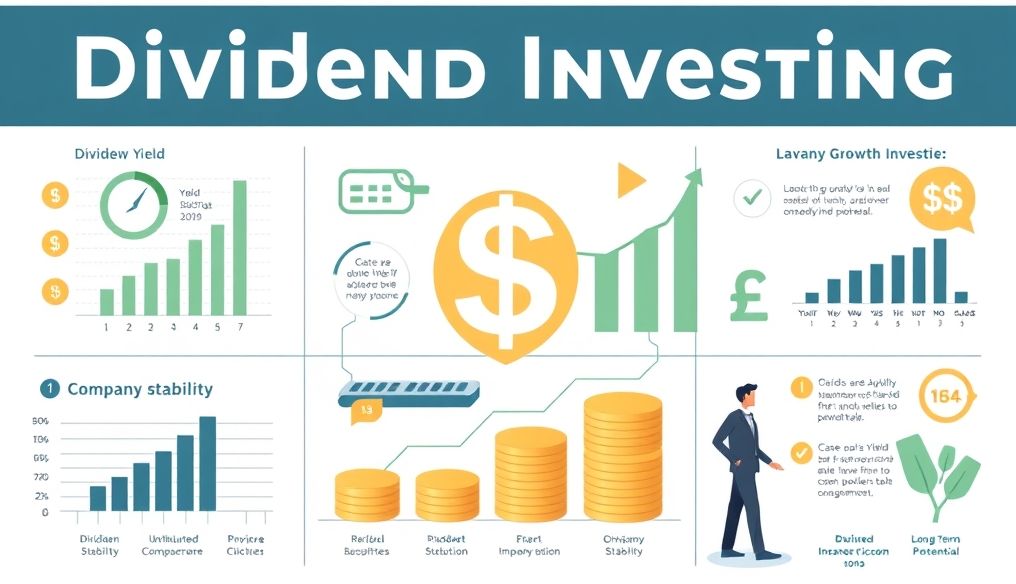مقدمة إلى أسهم الأرباح: نافذة نحو الدخل السلبي
في عالم الاستثمار، تبرز أسهم الأرباح كخيار جذاب للمستثمرين الذين يسعون إلى تحقيق دخل سلبي مستدام وبناء ثروة طويلة الأجل. هذه الأسهم، التي تصدرها الشركات التي توزع جزءًا من أرباحها على المساهمين، تقدم مزيجًا فريدًا من النمو المحتمل والدخل المنتظم، مما يجعلها خيارًا مثاليًا للمستثمرين المبتدئين والمخضرمين على حد سواء.
الفصل الأول: ما هي أسهم الأرباح وما الذي يميزها؟
أسهم الأرباح هي أسهم الشركات التي تقوم بتوزيع جزء من أرباحها على المساهمين بشكل دوري، عادةً كل ربع سنة أو سنوياً. هذه التوزيعات النقدية، المعروفة باسم الأرباح، تمثل عائدًا إضافيًا للمستثمرين بالإضافة إلى أي مكاسب رأسمالية محتملة من ارتفاع سعر السهم.
الفرق بين أسهم الأرباح وأسهم النمو
- أسهم الأرباح: تركز على توزيع الأرباح النقدية للمساهمين، وتتميز باستقرار نسبي في الأداء.
- أسهم النمو: تركز على زيادة قيمة السهم من خلال إعادة استثمار الأرباح في الشركة، وتتميز بتقلبات أعلى في الأداء.
الفصل الثاني: لماذا الاستثمار في أسهم الأرباح؟
الاستثمار في أسهم الأرباح يقدم العديد من المزايا، بما في ذلك:
- الدخل السلبي: توفر الأرباح النقدية تدفقًا منتظمًا للدخل، مما يساعد على تحقيق الاستقلال المالي.
- الاستقرار: تميل الشركات التي تدفع أرباحًا إلى أن تكون أكثر استقرارًا ونضجًا من الشركات التي لا تدفع أرباحًا.
- الحماية من التضخم: غالبًا ما تزيد الشركات التي تدفع أرباحًا من توزيعاتها بمرور الوقت، مما يساعد على حماية المستثمرين من تأثير التضخم.
- إعادة الاستثمار: يمكن إعادة استثمار الأرباح النقدية لشراء المزيد من الأسهم، مما يؤدي إلى نمو مضاعف في المحفظة الاستثمارية.
الفصل الثالث: كيفية اختيار أسهم الأرباح المناسبة: معايير أساسية
اختيار أسهم الأرباح المناسبة يتطلب دراسة متأنية وتحليل دقيق للعديد من العوامل، بما في ذلك:
نسبة العائد على الأرباح (Dividend Yield)
تمثل نسبة العائد على الأرباح النسبة المئوية للأرباح السنوية المدفوعة مقارنة بسعر السهم الحالي. تعتبر نسبة العائد على الأرباح الأعلى جاذبة للمستثمرين، ولكن يجب الانتباه إلى أن النسب العالية جدًا قد تشير إلى مشاكل مالية في الشركة.
نسبة تغطية الأرباح (Payout Ratio)
تمثل نسبة تغطية الأرباح النسبة المئوية للأرباح التي يتم توزيعها على المساهمين. تشير نسبة التغطية المنخفضة إلى أن الشركة لديها مساحة كافية لزيادة توزيعات الأرباح في المستقبل.
تاريخ توزيعات الأرباح
ابحث عن الشركات التي لديها تاريخ طويل من توزيعات الأرباح المنتظمة والمتزايدة. هذا يشير إلى أن الشركة ملتزمة بمكافأة المساهمين ولديها القدرة على الحفاظ على توزيعات الأرباح في المستقبل.
الوضع المالي للشركة
قم بتحليل البيانات المالية للشركة، بما في ذلك الميزانية العمومية وقائمة الدخل وقائمة التدفقات النقدية، لتقييم صحتها المالية وقدرتها على توليد الأرباح في المستقبل.
القطاع الذي تنتمي إليه الشركة
تعتبر بعض القطاعات أكثر ملاءمة للاستثمار في أسهم الأرباح من غيرها. على سبيل المثال، غالبًا ما تكون شركات المرافق العامة والاتصالات والطاقة شركات ناضجة ذات تدفقات نقدية مستقرة، مما يجعلها خيارات جيدة للمستثمرين الذين يبحثون عن دخل ثابت.
الفصل الرابع: استراتيجيات الاستثمار في أسهم الأرباح
هناك العديد من الاستراتيجيات التي يمكن للمستثمرين اتباعها للاستثمار في أسهم الأرباح، بما في ذلك:
شراء والاحتفاظ (Buy and Hold)
تتضمن هذه الاستراتيجية شراء أسهم الأرباح عالية الجودة والاحتفاظ بها لفترة طويلة الأجل، مع إعادة استثمار الأرباح النقدية لشراء المزيد من الأسهم. هذه الاستراتيجية بسيطة وفعالة، وتسمح للمستثمرين بالاستفادة من النمو المضاعف للأرباح على المدى الطويل.
الاستثمار في صناديق المؤشرات المتداولة (ETFs) التي تركز على الأرباح
توفر صناديق المؤشرات المتداولة التي تركز على الأرباح طريقة سهلة ومتنوعة للاستثمار في مجموعة واسعة من أسهم الأرباح. هذه الصناديق تتبع مؤشرات أسهم الأرباح، مما يوفر للمستثمرين تعرضًا فوريًا لمجموعة متنوعة من الشركات التي تدفع أرباحًا.
الاستثمار في الشركات التي تزيد من توزيعات الأرباح باستمرار
ابحث عن الشركات التي لديها تاريخ طويل من زيادة توزيعات الأرباح سنويًا. هذه الشركات غالبًا ما تكون شركات قوية ومستقرة لديها القدرة على توليد الأرباح في المستقبل.
الفصل الخامس: المخاطر المرتبطة بالاستثمار في أسهم الأرباح وكيفية إدارتها
على الرغم من أن الاستثمار في أسهم الأرباح يقدم العديد من المزايا، إلا أنه لا يخلو من المخاطر. بعض المخاطر الرئيسية تشمل:
- تخفيض أو تعليق توزيعات الأرباح: قد تقوم الشركات بتخفيض أو تعليق توزيعات الأرباح في أوقات الصعوبات المالية، مما يؤدي إلى انخفاض الدخل للمستثمرين.
- انخفاض سعر السهم: قد ينخفض سعر سهم الشركة التي تدفع أرباحًا إذا كانت تعاني من مشاكل مالية أو إذا كان أداء القطاع الذي تنتمي إليه ضعيفًا.
- مخاطر التضخم: قد لا تواكب توزيعات الأرباح ارتفاع معدل التضخم، مما يؤدي إلى تآكل القوة الشرائية للدخل.
كيفية إدارة المخاطر
- التنويع: قم بتنويع محفظتك الاستثمارية من خلال الاستثمار في مجموعة متنوعة من أسهم الأرباح في مختلف القطاعات.
- البحث والتحليل: قم بإجراء بحث وتحليل شامل للشركات قبل الاستثمار في أسهمها.
- المراقبة المستمرة: قم بمراقبة أداء الشركات التي تستثمر فيها بشكل مستمر وكن على استعداد لبيع الأسهم إذا كانت تعاني من مشاكل مالية.
الفصل السادس: أمثلة واقعية لشركات عربية وعالمية ناجحة في توزيع الأرباح
فيما يلي بعض الأمثلة لشركات عربية وعالمية ناجحة في توزيع الأرباح:
أمثلة عربية
- شركة الاتصالات السعودية (STC): تعتبر من أكبر شركات الاتصالات في المنطقة وتتميز بتوزيعات أرباح منتظمة وجذابة.
- البنك الأهلي السعودي (SNB): يعتبر من أكبر البنوك في المملكة العربية السعودية ويوزع أرباحًا جيدة على المساهمين.
أمثلة عالمية
- جونسون آند جونسون (Johnson & Johnson): شركة عالمية رائدة في مجال الرعاية الصحية وتتميز بتاريخ طويل من توزيعات الأرباح المتزايدة.
- بروكتر آند جامبل (Procter & Gamble): شركة عالمية رائدة في مجال السلع الاستهلاكية وتتميز بتوزيعات أرباح مستقرة وجذابة.
الفصل السابع: الضرائب على أرباح الأسهم: ما تحتاج إلى معرفته
تخضع أرباح الأسهم للضرائب في معظم البلدان. تختلف قوانين الضرائب المتعلقة بأرباح الأسهم من بلد إلى آخر، لذلك من المهم استشارة مستشار ضريبي للحصول على معلومات محددة حول الضرائب التي قد يتعين عليك دفعها.
في بعض البلدان، قد يتم فرض ضريبة على أرباح الأسهم بمعدل أقل من ضريبة الدخل العادية، مما يجعلها خيارًا جذابًا للمستثمرين.
الفصل الثامن: الأدوات والموارد المتاحة لتحليل أسهم الأرباح
هناك العديد من الأدوات والموارد المتاحة للمستثمرين لتحليل أسهم الأرباح، بما في ذلك:
- المواقع الإلكترونية المالية: توفر المواقع الإلكترونية المالية مثل Yahoo Finance و Google Finance معلومات مفصلة حول الشركات، بما في ذلك البيانات المالية وتوزيعات الأرباح.
- برامج تحليل الأسهم: توفر برامج تحليل الأسهم أدوات متقدمة لتحليل البيانات المالية وتقييم أسهم الأرباح.
- التقارير البحثية: تصدر شركات الوساطة المالية تقارير بحثية حول الشركات، والتي يمكن أن توفر رؤى قيمة حول أدائها المالي وتوقعاتها المستقبلية.
الفصل التاسع: نصائح عملية للمستثمرين المبتدئين في أسهم الأرباح
إذا كنت مستثمرًا مبتدئًا في أسهم الأرباح، فإليك بعض النصائح العملية التي يمكن أن تساعدك على البدء:
- ابدأ بمبلغ صغير: لا تستثمر مبلغًا كبيرًا من المال في البداية. ابدأ بمبلغ صغير يمكنك تحمل خسارته وتعلم أثناء تقدمك.
- ركز على الشركات المعروفة: استثمر في الشركات المعروفة التي لديها تاريخ طويل من توزيعات الأرباح المنتظمة.
- كن صبوراً: الاستثمار في أسهم الأرباح هو استثمار طويل الأجل. لا تتوقع تحقيق أرباح سريعة.
- اطلب المشورة المهنية: إذا كنت غير متأكد من كيفية البدء، فاطلب المشورة من مستشار مالي مؤهل.
الفصل العاشر: مستقبل أسهم الأرباح في ظل التغيرات الاقتصادية
على الرغم من التحديات الاقتصادية المتزايدة، تظل أسهم الأرباح خيارًا استثماريًا جذابًا للمستثمرين الذين يبحثون عن دخل سلبي مستدام. الشركات التي تدفع أرباحًا غالبًا ما تكون أكثر استقرارًا ونضجًا من الشركات التي لا تدفع أرباحًا، مما يجعلها قادرة على تحمل فترات الركود الاقتصادي.
مع ذلك، من المهم أن يكون المستثمرون على دراية بالمخاطر المرتبطة بالاستثمار في أسهم الأرباح وأن يقوموا بتنويع محافظهم الاستثمارية وإجراء بحث وتحليل شامل للشركات قبل الاستثمار في أسهمها.
إخلاء المسؤولية: هذا المقال هو لأغراض إعلامية فقط ولا ينبغي اعتباره نصيحة استثمارية. يجب على المستثمرين استشارة مستشار مالي مؤهل قبل اتخاذ أي قرارات استثمارية.




